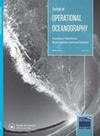黑潮延伸区中尺度冷涡三维结构的详细研究*
IF 2.4
3区 地球科学
Q4 METEOROLOGY & ATMOSPHERIC SCIENCES
引用次数: 5
摘要
北太平洋黑潮延伸区(Kuroshio Extension Region, KER)拥有最活跃的海洋中尺度涡旋,但目前缺乏对这些涡旋三维精细结构的观测。2014年6月,利用卫星高度计数据和海上观测资料,对克尔地区一个中尺度气旋涡旋的三维温盐结构和环流进行了精细表征。结果表明,6个原位剖面的等温线一致表现出增强的向上弯曲,负温度异常明显。在靠近涡旋中心的位置,负温度异常变得更加显著,冷核的强度变得更加明显。等盐线也呈上升趋势,上层和下层分别有负异常和正异常。各层的等盐线从地下至1000米均表现出明显的涡状结构。ADCP实测流场和基于温盐数据的地转流场均显示出明显的不对称气旋环流结构。混合坐标海洋模式(HYCOM)能较好地描述中尺度涡旋,但涡旋的大小和位置与原位观测存在一定偏差。本文章由计算机程序翻译,如有差异,请以英文原文为准。
Detailed investigation of the three-dimensional structure of a mesoscale cold eddy in the Kuroshio extension region*
ABSTRACT The Kuroshio Extension Region (KER) has the most active oceanic mesoscale eddies within the North Pacific Ocean, nevertheless, there is a lack of observations on the three-dimensional (3D) fine structure of these eddies. Satellite altimeter data and underway observations were used in combination to conduct a fine-scale characterisation of the 3D thermohaline structure and circulation of a mesoscale cyclonic eddy within the KER during June, 2014. The results showed that isotherms in the six in situ sections consistently exhibited enhanced upward bending and negative temperature anomalies were distinct. At locations closer to the centre of the eddy, the negative temperature anomalies became more significant and the intensity of the cold core became more pronounced. The isohalines also trended upwards, with the upper and lower levels having negative and positive anomalies, respectively. The isohalines at the various layers similarly exhibited a clear eddy-like structure from the subsurface down to 1,000 m. Both the actual flow field measured by the Acoustic Doppler Current Profiler (ADCP) and the geostrophic flow field based on thermohaline data indicated a significant asymmetric cyclonic circulation structure. By comparing with the in situ data, the HYbrid Coordinate Ocean Model (HYCOM) is capable of depicting the mesoscale eddy while the magnitude and eddy location deviate from in situ observations.
求助全文
通过发布文献求助,成功后即可免费获取论文全文。
去求助
来源期刊
CiteScore
7.50
自引率
9.70%
发文量
8
审稿时长
>12 weeks
期刊介绍:
The Journal of Operational Oceanography will publish papers which examine the role of oceanography in contributing to the fields of: Numerical Weather Prediction; Development of Climatologies; Implications of Ocean Change; Ocean and Climate Forecasting; Ocean Observing Technologies; Eutrophication; Climate Assessment; Shoreline Change; Marine and Sea State Prediction; Model Development and Validation; Coastal Flooding; Reducing Public Health Risks; Short-Range Ocean Forecasting; Forces on Structures; Ocean Policy; Protecting and Restoring Ecosystem health; Controlling and Mitigating Natural Hazards; Safe and Efficient Marine Operations

 求助内容:
求助内容: 应助结果提醒方式:
应助结果提醒方式:


